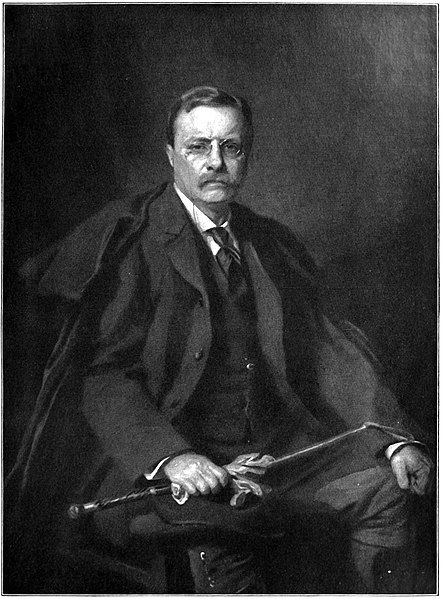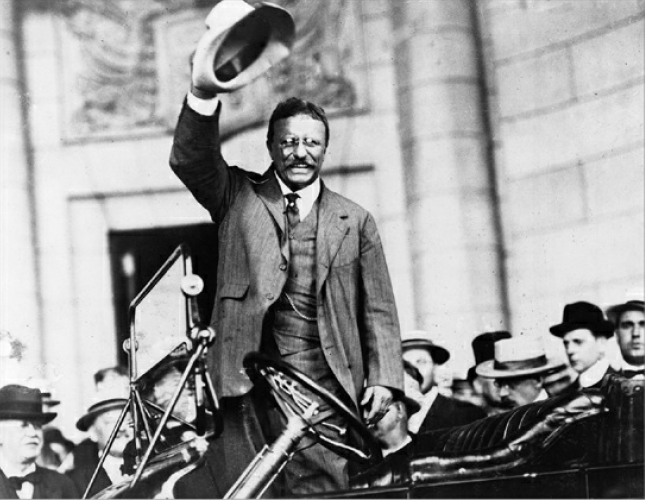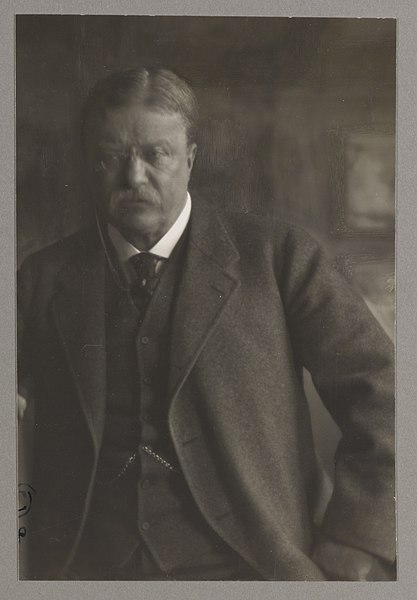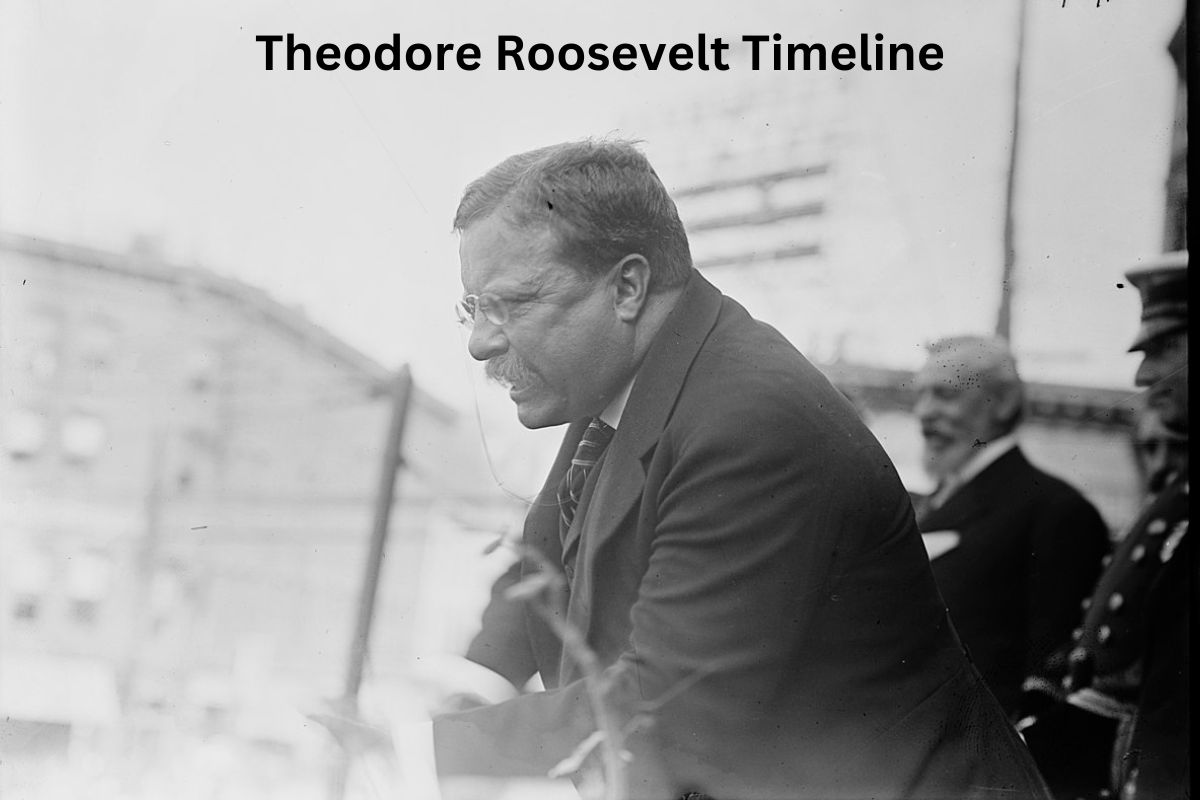Theodore Roosevelt (1858-1919) was a prominent American leader. He served as the 26th President of the United States after President McKinley’s assassination.
Roosevelt was known for progressive reforms, trust-busting, and conservation efforts. He received the Nobel Peace Prize in 1906 for negotiating the end of the Russo-Japanese War. He later ran as a third-party candidate in 1912.
Roosevelt died in 1919 at his home in Oyster Bay, New York, leaving a lasting legacy in American politics and conservation.
| Year | Event |
|---|---|
| 1858 | Theodore Roosevelt is born in New York City, New York. |
| 1876 | Roosevelt enters Harvard College. |
| 1880 | Graduates from Harvard and marries Alice Hathaway Lee. |
| 1881 | Elected to the New York State Assembly. |
| 1884 | Loses his mother and wife on the same day – his mother to typhoid fever and his wife to nephritis. |
| 1887 | Moves to the Badlands of North Dakota to ranch and hunt. |
| 1889 | Returns to New York City after the deaths of his wife and mother. |
| 1895 | Appointed as President of the New York City Police Commission. |
| 1897 | Becomes Assistant Secretary of the Navy under President William McKinley. |
| 1898 | Resigns from his position in the Navy Department to organize the 1st U.S. Volunteer Cavalry Regiment, known as the “Rough Riders,” during the Spanish-American War. |
| 1898 | Roosevelt and the Rough Riders gain fame for their charge up San Juan Hill in Cuba. |
| 1899 | Elected as Governor of New York. |
| 1901 | Becomes the 26th President of the United States after the assassination of President William McKinley. |
| 1902 | Roosevelt brokers the end of the Coal Strike, demonstrating his willingness to intervene in labor disputes. |
| 1903 | Negotiates the construction of the Panama Canal. |
| 1904 | Wins re-election as President, becoming the first President to be elected in his own right after assuming office due to the death of his predecessor. |
| 1906 | Receives the Nobel Peace Prize for his role in negotiating the end of the Russo-Japanese War. |
| 1907-1909 | Advocates for progressive domestic policies, including trust-busting, food and drug regulation, and conservation efforts. |
| 1908 | Declines to run for re-election and supports William Howard Taft as his successor. |
| 1912 | Runs for president as a third-party candidate, representing the Progressive Party (also known as the Bull Moose Party). |
| 1919 | Dies in his sleep at his home in Oyster Bay, New York, at the age of 60. |
Timeline of Theodore Roosevelt
October 27, 1858: Theodore Roosevelt is born in New York City, New York
Theodore Roosevelt, often referred to as Teddy or T.R., was born on October 27, 1858, into a wealthy and prominent New York City family. He was the second of four children and was born into a life of privilege.

1876: Roosevelt enters Harvard College
In 1876, at the age of 18, Roosevelt enrolled at Harvard College. During his time at Harvard, he developed a keen interest in natural history and boxing. He was an active student and a member of various clubs and organizations.
1880: Graduates from Harvard and marries Alice Hathaway Lee
In 1880, Roosevelt graduated from Harvard with a Bachelor of Arts degree. Shortly after graduating, he married Alice Hathaway Lee, a childhood friend. However, their happiness was short-lived as tragedy struck their family.
1881: Elected to the New York State Assembly
In 1881, at the age of 23, Roosevelt was elected to the New York State Assembly as a Republican. During his time in the Assembly, he focused on reform issues, including civil service reform and government transparency.
Also Read: Theodore Roosevelt Accomplishments
His political career was launched, and he quickly gained a reputation as a progressive and energetic legislator.
1884: Loses his mother and wife on the same day – his mother to typhoid fever and his wife to nephritis
1884 was a devastating year for Roosevelt. On February 14, 1884, his mother, Martha “Mittie” Roosevelt, died of typhoid fever.
Tragically, just hours later, on the same day, Roosevelt’s wife, Alice Hathaway Lee Roosevelt, died of nephritis.
Also Read: Theodore Roosevelt Facts
These dual losses had a profound impact on him, and he retreated to the Badlands of North Dakota to cope with his grief.

1887: Moves to the Badlands of North Dakota to ranch and hunt
Following the tragic deaths of his mother and wife, Theodore Roosevelt sought solace and adventure in the Badlands of North Dakota. In 1884, he had purchased a cattle ranch in the Badlands and decided to move there in 1887.
Roosevelt embraced the rugged lifestyle, working as a rancher and spending time hunting and exploring the western frontier. This experience greatly influenced his views on conservation and the environment.
1889: Returns to New York City
After spending several years in the Badlands, Roosevelt returned to New York City in 1889. He continued his political career by running for various positions, including the New York City Board of Police Commissioners, where he initiated significant reforms to combat corruption and improve law enforcement.
1895: Appointed as President of the New York City Police Commission
In 1895, Roosevelt was appointed as the President of the New York City Police Commission, a position he accepted on the condition that he would have full authority to reform the corrupt police department.
He implemented several reforms, such as requiring officers to wear badges, instituting regular physical fitness tests, and increasing discipline within the force. His efforts earned him a reputation as a reformer and a champion of law and order.
1897: Becomes Assistant Secretary of the Navy under President William McKinley
In 1897, Theodore Roosevelt was appointed as the Assistant Secretary of the Navy in President William McKinley’s administration.
In this role, he advocated for the modernization and expansion of the U.S. Navy. He believed in a strong navy as a means to protect American interests and influence on the world stage.

1898: Resigns from his position in the Navy Department to organize the 1st U.S. Volunteer Cavalry Regiment, known as the “Rough Riders,” during the Spanish-American War
During the Spanish-American War in 1898, Theodore Roosevelt resigned from his position in the Navy Department to organize and lead a volunteer cavalry unit known as the “Rough Riders.”
This group of soldiers, consisting of a diverse mix of cowboys, college athletes, and outdoorsmen, played a prominent role in the Battle of San Juan Hill in Cuba.
1898: Roosevelt and the Rough Riders gain fame for their charge up San Juan Hill in Cuba
One of the most iconic moments in Theodore Roosevelt’s military career occurred during the Spanish-American War in 1898. He and his Rough Riders, along with other U.S. forces, participated in the Battle of San Juan Hill in Cuba.
Roosevelt’s leadership and the Rough Riders’ bravery during the charge up the hill earned them national recognition and made Roosevelt a hero.
1899: Elected as Governor of New York
After his return from the Spanish-American War, Theodore Roosevelt entered New York politics. In 1899, he was elected as the Governor of New York.
During his tenure, he continued to champion progressive policies, such as trust-busting and government reform. His successful term as governor helped establish his reputation as a reform-minded leader.
1901: Becomes the 26th President of the United States after the assassination of President William McKinley
In 1901, Theodore Roosevelt’s political career took a historic turn when President William McKinley was assassinated. Roosevelt, who had been serving as Vice President, was suddenly thrust into the role of the 26th President of the United States.
He was inaugurated on September 14, 1901, and became the youngest president in U.S. history at the age of 42.
1902: Roosevelt brokers the end of the Coal Strike, demonstrating his willingness to intervene in labor disputes
In 1902, Theodore Roosevelt faced a major labor crisis when a coal miners’ strike threatened to leave much of the country without heating fuel during the winter.
Roosevelt took an unprecedented step by intervening in the dispute and personally mediating negotiations between the mine owners and labor unions.
His intervention resulted in a favorable settlement for the workers and demonstrated his commitment to resolving labor disputes for the public good.
1903: Negotiates the construction of the Panama Canal
One of Roosevelt’s most significant achievements as president was his involvement in the negotiation and construction of the Panama Canal. He pushed for the acquisition of the rights to build the canal through the Isthmus of Panama, which was then part of Colombia.
When negotiations with Colombia broke down, Roosevelt supported a Panamanian rebellion that led to the creation of the independent Republic of Panama. Shortly thereafter, the U.S. signed a treaty with Panama and began the construction of the canal, which revolutionized global trade and transportation.
1904: Wins re-election as President, becoming the first President to be elected in his own right after assuming office due to the death of his predecessor
In the 1904 presidential election, Theodore Roosevelt ran for re-election as the incumbent president. He won a decisive victory, becoming the first president to be elected in his own right after ascending to the presidency due to the assassination of his predecessor, William McKinley.
Roosevelt’s presidency was marked by progressive policies, and his second term allowed him to continue his reform agenda.
1906: Receives the Nobel Peace Prize for his role in negotiating the end of the Russo-Japanese War
One of Theodore Roosevelt’s most notable achievements was his successful mediation of the end of the Russo-Japanese War. In 1905, he helped negotiate the Treaty of Portsmouth, which ended the conflict between Russia and Japan.
For his efforts to promote peace, he was awarded the Nobel Peace Prize in 1906, making him the first American to receive the prestigious award.
1907-1909: Advocates for progressive domestic policies, including trust-busting, food and drug regulation, and conservation efforts
During his presidency, Roosevelt was a leading advocate for progressive policies. He pursued a vigorous trust-busting campaign, targeting monopolistic corporations to promote fair competition.
He also signed into law the Pure Food and Drug Act and the Meat Inspection Act, which aimed to ensure the safety of food and pharmaceuticals. Additionally, he was a staunch conservationist, setting aside millions of acres of public lands for national parks, forests, and monuments.
1908: Declines to run for re-election and supports William Howard Taft as his successor
In 1908, Theodore Roosevelt made the surprising decision not to seek re-election for a third term. Instead, he supported William Howard Taft as the Republican candidate for the presidency. Taft went on to win the election and became the 27th President of the United States, succeeding Roosevelt.
1912: Runs for president as a third-party candidate, representing the Progressive Party (also known as the Bull Moose Party)
In 1912, dissatisfied with President Taft’s leadership and the direction of the Republican Party, Theodore Roosevelt decided to run for president again, this time as a third-party candidate representing the Progressive Party, often referred to as the Bull Moose Party.
He campaigned vigorously on a platform of progressive reforms, but he ultimately split the Republican vote, allowing Woodrow Wilson, the Democratic candidate, to win the presidency.
1919: Dies in his sleep at his home in Oyster Bay, New York, at the age of 60
After leaving office, Theodore Roosevelt remained active in public life and continued to write and lecture. However, his health began to decline in the years following his presidency. On January 6, 1919, at the age of 60, he passed away in his sleep at his home in Oyster Bay, New York. His death marked the end of a dynamic and influential era in American politics.
